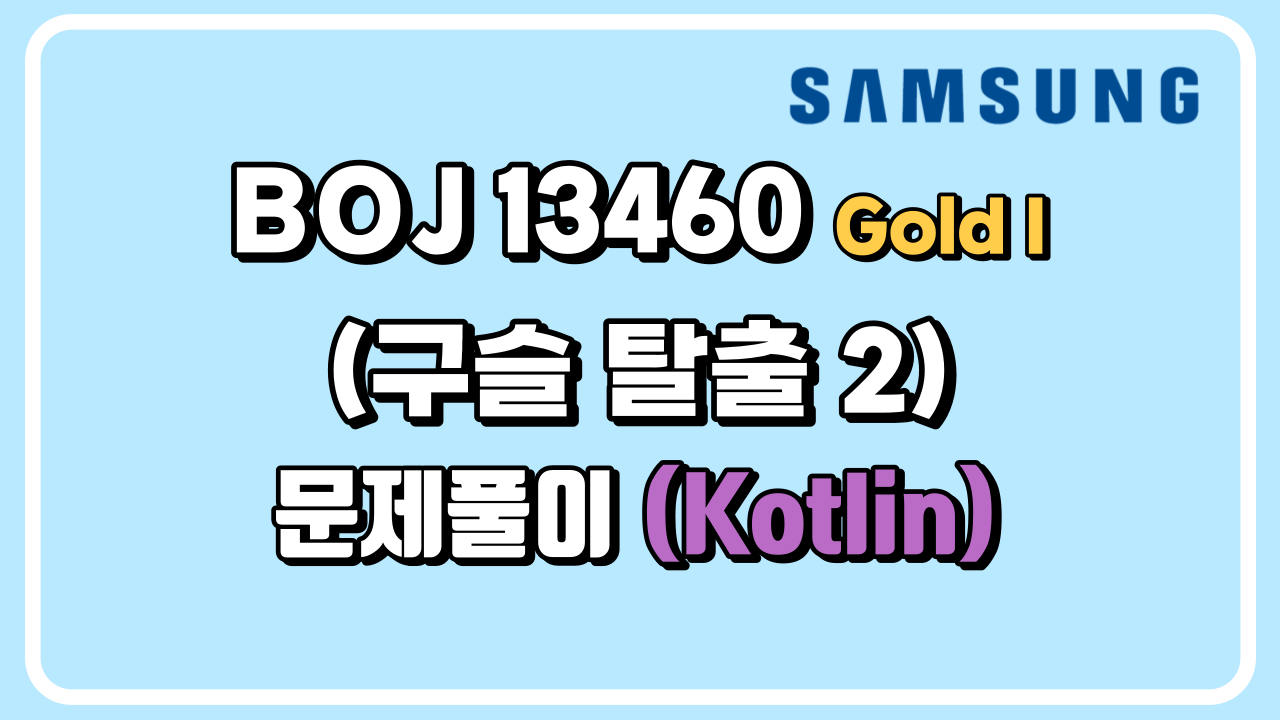
풀이
이 문제도 문제를 잘 읽고 단계별로 코드를 작성하시면 푸실 수 있습니다.
만은..! 예외처리를 빡세게 해주셔야 합니다.
참고 사항
이 문제는 일반적인 2차원 배열에서의 BFS의 개념을 담고 있습니다. 그러나 빨간공, 파란공의 위치에 대해서는 수많은 경우의 수가 존재합니다.
따라서, 노드의 방문을 체크하는 isVisited 배열을 4차원 배열로 선언하여 두 공의 위치에 대한 모든 경우의 수를 따져주셔야 합니다.
Data class
이 문제를 쉽고 직관적으로 풀기위해서는 R공의 위치, B공의 위치, 총 이동횟수를 담은 Data class를 생성해주셔야 합니다.
data class Pos(var x: Int, var y: Int)
data class Marble(
val R: Pos,
val B: Pos,
val cnt: Int
)공을 벽까지 보내야 한다.
이 문제는 다른 BFS문제에서 1칸 씩 이동하는 것과 달리, 한 번 이동으로 벽 까지 보내야 합니다.
따라서, 빨간 구슬, 파란 구슬 모두 벽 까지 보내는 것이 중요합니다.
fun moveMarble(x: Int, y: Int, dir: Int): Pos {
isHole = false
val pos = Pos(x, y)
while (board[pos.y + dy[dir]][pos.x + dx[dir]] != '#') {
pos.x += dx[dir]
pos.y += dy[dir]
if (board[pos.y][pos.x] == 'O') {
isHole = true
return pos
}
}
return pos
}BFS 수행
이제 두 구슬을 상하좌우로 이동시켜 정답을 도출해야합니다.
앞서 설명 드린 구슬 이동 메서드를 통해 두 구슬을 벽까지 보내고, 만약 두 구슬의 포지션이 겹친다면 원래의 포지션을 참고하여 구슬 위치를 재조정해야 합니다.
fun rollingInTheHole(posR: Pos, posB: Pos): Int {
val isVisited = Array(R) { Array(C) { Array(R) { BooleanArray(C) } } }
val q: Queue<Marble> = LinkedList<Marble>()
q.offer(Marble(posR, posB, 0))
isVisited[posR.y][posR.x][posB.y][posB.x] = true
while (!q.isEmpty()) {
val cur = q.poll()
// 만약 이동 횟수가 10 이상이면 게임 종료.
if (cur.cnt == 10) return -1
for (i in 0 until 4) {
/** 파란 구슬 이동 **/
var nextB = moveMarble(cur.B.x, cur.B.y, i)
if (isHole) continue
// 파란 구슬이 구멍에 들어가면 게임은 끝나지만, 뒤에 다른 경우도 봐야하기 때문에 continue.
/** 빨간 구슬 이동 **/
var nextR = moveMarble(cur.R.x, cur.R.y, i)
if (isHole) return cur.cnt + 1
/** 방향에 따른 구슬 위치 조정 **/
if (nextR == nextB) {
when(i) {
0 -> {
if (cur.R.y > cur.B.y) {
nextR.y++
} else {
nextB.y++
}
}
1 -> {
if (cur.R.x < cur.B.x) {
nextR.x--
} else {
nextB.x--
}
}
2 -> {
if (cur.R.y < cur.B.y) {
nextR.y--
} else {
nextB.y--
}
}
3 -> {
if (cur.R.x > cur.B.x) {
nextR.x++
} else {
nextB.x++
}
}
}
}
if (isVisited[nextR.y][nextR.x][nextB.y][nextB.x]) continue
isVisited[nextR.y][nextR.x][nextB.y][nextB.x] = true
q.offer(Marble(nextR, nextB, cur.cnt + 1))
}
}
return -1
}Source Code
package 삼성SW역량테스트.`13460번_구슬탈출2`
import java.util.*
private lateinit var board: Array<CharArray>
private val dy = arrayOf(-1, 0, 1, 0)
private val dx = arrayOf(0, 1, 0, -1)
private var isHole = false
var R = 0
var C = 0
fun main() {
val (r, c) = readln().split(" ").map { it.toInt() }
R = r ; C = c
var posR = Pos(0, 0)
var posB = Pos(0, 0)
board = Array(R) { CharArray(C) }
for (i in 0 until R) {
val part = readln()
for (j in 0 until C) {
board[i][j] = part[j]
if (board[i][j] == 'R') {
posR = Pos(j, i)
board[i][j] = '.'
}
if (board[i][j] == 'B') {
posB = Pos(j, i)
board[i][j] = '.'
}
}
}
println(rollingInTheHole(posR, posB))
}
fun rollingInTheHole(posR: Pos, posB: Pos): Int {
val isVisited = Array(R) { Array(C) { Array(R) { BooleanArray(C) } } }
val q: Queue<Marble> = LinkedList<Marble>()
q.offer(Marble(posR, posB, 0))
isVisited[posR.y][posR.x][posB.y][posB.x] = true
while (!q.isEmpty()) {
val cur = q.poll()
if (cur.cnt == 10) return -1
for (i in 0 until 4) {
/** 파란 구슬 이동 **/
var nextB = moveMarble(cur.B.x, cur.B.y, i)
if (isHole) continue
// 파란 구슬이 구멍에 들어가면 게임은 끝나지만, 뒤에 다른 경우도 봐야하기 때문에 continue.
/** 빨간 구슬 이동 **/
var nextR = moveMarble(cur.R.x, cur.R.y, i)
if (isHole) return cur.cnt + 1
/** 방향에 따른 구슬 위치 조정 **/
if (nextR == nextB) {
when(i) {
0 -> {
if (cur.R.y > cur.B.y) {
nextR.y++
} else {
nextB.y++
}
}
1 -> {
if (cur.R.x < cur.B.x) {
nextR.x--
} else {
nextB.x--
}
}
2 -> {
if (cur.R.y < cur.B.y) {
nextR.y--
} else {
nextB.y--
}
}
3 -> {
if (cur.R.x > cur.B.x) {
nextR.x++
} else {
nextB.x++
}
}
}
}
if (isVisited[nextR.y][nextR.x][nextB.y][nextB.x]) continue
isVisited[nextR.y][nextR.x][nextB.y][nextB.x] = true
q.offer(Marble(nextR, nextB, cur.cnt + 1))
}
}
return -1
}
fun moveMarble(x: Int, y: Int, dir: Int): Pos {
isHole = false
val pos = Pos(x, y)
while (board[pos.y + dy[dir]][pos.x + dx[dir]] != '#') {
pos.x += dx[dir]
pos.y += dy[dir]
if (board[pos.y][pos.x] == 'O') {
isHole = true
return pos
}
}
return pos
}
data class Pos(var x: Int, var y: Int)
data class Marble(
val R: Pos,
val B: Pos,
val cnt: Int
)